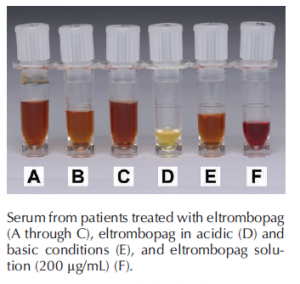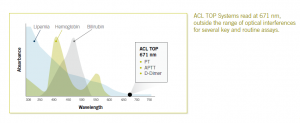From my friend Ali Sadeghi-Khomami, PhD, Precision Biologic Inc: Eltrombopag is a diazo derived compound that acts like pH indicators, i. e., it changes colour at different concentrations of hydronium ions. Thus it is expected that it interferes with chromogenic assays such as the bilirubin assay, especially when assay calibration will not match the colour of the testing sample.
However, optical coagulometers are a different story. When they are used in clot detection mode, the change in optical density (OD) will be followed. These changes could be set up in protocols differently, e.g. maximum rate (speed) or acceleration change in OD could be considered as the clotting point. In brief, they work based on relative change in OD measurements but not the absolute OD values.

IL’s TOP instruments claim that at 671 nm results for prothrombin time and partial thromboplastin time (PT, APTT or PTT) tests won’t be affected by bilirubin and hemoglobin colours. Obviously this is not the case for 405 nm wavelength available on TOP for chromogenic assay.

Siemens’ BCS-XP is another popular optical coagulometer that offers 340, 405 and 570 nm wavelengths. A brownish solution has roughly absorption around ~400–500 nm range and in theory should be OK for analysis of PT and PTT assays at 570 nm. The safest approach here is to use mechanical coagulometers for clot detection of plasma samples with unusual colors.
Having said that, the CLSI H25-A5 recommendation still needs to be followed:
“Some current instruments using an optical end-point determination may have problems with samples that are icteric, lipemic, or contain substances that interfere with light transmission. Ultracentrifugation has been suggested in some circumstances, however there are no published studies. In a small, unpublished study of lipemic samples, PT and PTT assays were decreased and fibrinogen levels were increased by about 10–15%. Until published studies are performed or the laboratory has validated the procedure, mechanical and/or electromechanical methods for clot detection should be utilized when possible for those samples that are icteric, lipemic, or contain substances that interfere with light transmission.”


No comments here.